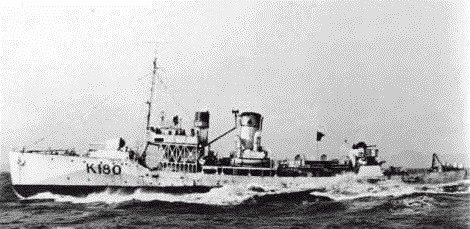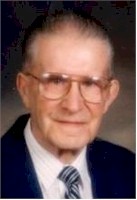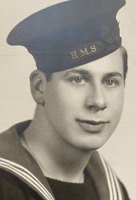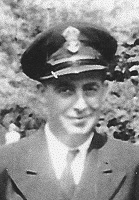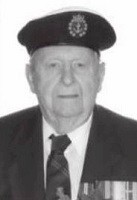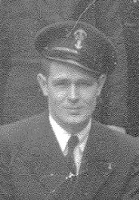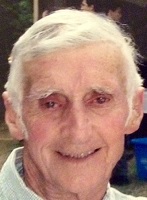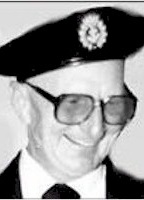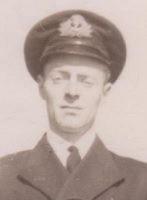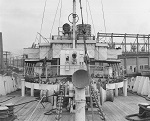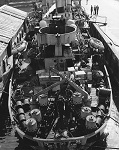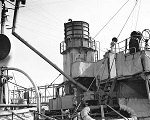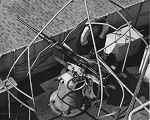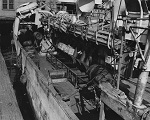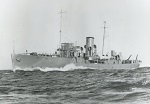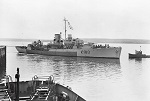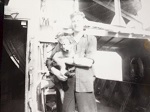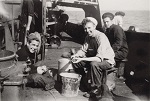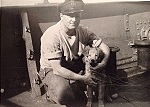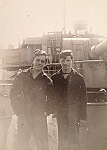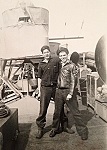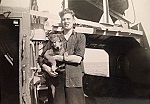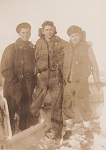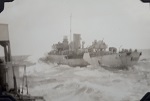|
HMCS COLLINGWOOD K180
Flower Class Corvette
The first RCN corvette to enter service, COLLINGWOOD was commissioned on 09 Nov 1940 at COLLINGWOOD, Ontario. She arrived at Halifax 04 Dec 1940, and joined Halifax Force in Jan 1941. She sailed on 23 May 1941 as one of the seven corvettes that were charter members of Newfoundland Command, and in Jun 1941 commenced six months' employment as an escort between St. John's and Iceland. Early in Dec 1941 she began a two-month refit at Halifax, following which she resumed mid-ocean escort duties between St. John's and Londonderry. These duties continued, with time off for three minor refits, until the end of 1944. From Dec 1942, onward she was a member of EG C-4. COLLINGWOOD was involved in one major convoy battle, that of HX.133 in Jun 1941, when eight ships were torpedoed and six sunk. During her refit at New York City from Oct to Dec 1943, she received her extended fo'c's'le. She left Londonderry on 16 Nov 1944, for the last time, refitted briefly at Liverpool, N.S., then went to Digby to serve as a training ship from Apr to Jun 1945. She was paid off on 23 Jul 1945 and laid up at Sorel. She was sold in Jul 1950 and broken up by Steel Co. of Canada, Hamilton, Ont., the same year.
Photos and Documents Ship's company photos Battle for Convoy HX-133
Commanding Officers
AB, RCNVR died - 05 May 1943
They shall not be forgotten
Former Crew Members
Photos and Documents
(CLW001-CLW005) HMCS COLLINGWOOD K180 - RCN photos // Source-Credit: Library and Archives of Canada
(CLW006) HMCS COLLINGWOOD K180 - RCN photo // Source-Credit: Library and Archives of Canada (CLW007) HMCS COLLINGWOOD K180 during builder's trials. Note she has no gun and is not flying an ensign - RCN photo (CLW008) HMCS COLLINGWOOD K180 (CLW009) HMCS COLLINGWOOD K180 - Click here to view a cropped and zoomed in image of this photo (CLW010) HMCS COLLINGWOOD K180 // From the collection of Eric Baird // Courtesy of Roger Clarke
(CLW011) Newspaper article on Ralph "Jigger" Mott returning to COLLINGWOOD for a reunion of the original HMCS COLLINGWOOD crew // From: The COLLINGWOOD Enterprise-Bulletin // Courtesy of Alexina Reid
(DB13) Douglas Keith Beach and the ship's mascot of HMCS COLLINGWOOD K350 (DB14) Douglas Keith Beach on HMCS COLLINGWOOD K350, Shelburne, NS, March 1945 (DB15-DB16) Sailors on HMCS COLLINGWOOD K350 peeling potatoes (DB17) Douglas Beach (right) and two shipmates on HMCS COLLINGWOOD K350
(DB18)Unknown sailor on HMCS COLLINGWOOD K350 with ship's mascot (DB19) Unknown sailor on HMCS COLLINGWOOD L350 with ship's mascot (DB20) Two unknown sailors on HMCS COLLINGWOOD K350 (DB21) Two unknown sailors on HMCS COLLINGWOOD K350 (DB22) Douglas Beach and shipmate "loading" forward gun of HMCS COLLINGWOOD K350. Note that part of the ship's gunshield art can be seen mounted on the bridge face.
(DB23) Douglas Beach with ship's mascot of HMCS COLLINGWOOD K350
(BD24) Unknown sailor on HMCS COLLINGWOOD K350
The 4-bulb light fixture is a bit of a mystery and there are opposing arguments as to its use. Here are two possible uses in the words of the men who were there:
1) "Four bulbs is a bit of a puzzle, but we had them as dim lights for ships following us when in 'Order 1' - line astern, so the dim people in the next astern didn't run into you. Not turned on when hunting a known or suspected U-boat! I thought there was only 1 medium blue light, but maybe there was an option, depending on local conditions. I know that when manoeuvering in company, if things got confused as to who was where, the C.O.'d order "Turn on stern light", or in extremis, "On navigation lights" which was port, starboard and masthead ... until things got sorted out! "
2) It was called quite simply, a "cluster". If you want to drop say a 10 charge pattern requiring; the clamping on and extracting of the charges from the ready-use storage, loading them onto the throwers, setting the depth, removing the keys, unscrewing the pistol and extracting the brass casing from a fired thrower, replacing it with new charge, firing simultaneously on queue, on the Q Deck of a heaving corvette in the middle of the ditch in the dark of night, with the PO ST in charge, screaming incoherently for no good reason, all without injuring or killing one or more of the crew, then, as Jesus said, "Let there be light, and with Moses being the LTO of the Watch, "Light there was" and the cluster burned merrily so that all could see.
From the collection of Douglas Beach, OS, RCNVR Courtesy of Robert Wilson
(LH02) PO Louis Hamilton (right) on HMCS COLLINGWOOD K180. Photo was taken after the refit in which her fo'c's'le was extended (LH03) PO Louis Hamilton (right) on the fo'c's'le of HMCS COLLINGWOOD K180 (LH04) Unknown sailor on the fo'c's'le of HMCS COLLINGWOOD K180 (LH05) Unknown sailor on the fo'c's'le of HMCS COLLINGWOOD K180 From the collection of Louis Hamilton, A/ERA 4c, RCNVR Courtesy of David Hamilton
(NV01) HMCS COLLINGWOOD K180 - photo taken from HMCS LANARK K669 // From the collection of Nick Vukson, Tel (S.O.), RCNVR // Courtesy of John Vukson (WC01) HMCS COLLINGWOOD K180 // Courtesy of Wayne Caswill (IC13) L-R: Unknown corvette, HMCS CAMROSE K154 and HMCS COLLINGWOOD K180 circa 1945 // From the collection of Ivan Chamberlain, AB AA3, RCNVR // Courtesy of Dave Chamberlain
|

